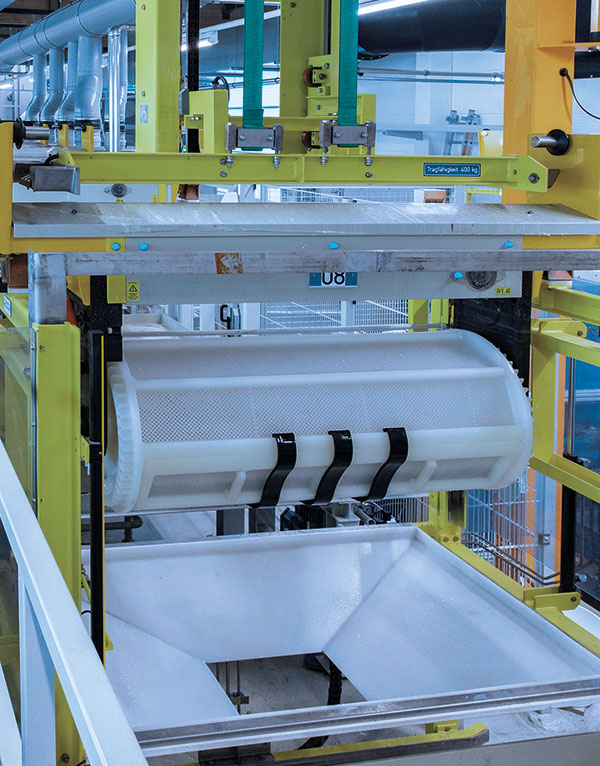Table of contents
What is custom software? | What is standard software? | Comparison | When does custom software make sense?
| Added value for the user | Costs | Implementation | Examples | Conclusion
July 10, 2024 | Authors: Maren Fichtner & André Nimtz | Reading time: approx. 17 minutes
Three fundamental questions about custom software
What is custom software?
The name says it all: custom software or individual software is software developed for a specific user or application. It is precisely tailored to the technical, organizational and functional requirements of the respective client.
How is custom software created?
Custom software can be developed in-house within the company. However, software developers from specialized companies or freelancers often come on board – especially if there is a lack of in-house implementation expertise. A mix of the individual groups is also conceivable and makes sense.
If you work with external parties, you can either conclude a contract for work or a service contract for the implementation of the custom software. With a contract for work and services, the development team works on a results-oriented basis. This means that the developers owe you a finished product, which you pay for after acceptance. With a service contract, on the other hand, the developers work on an activity-oriented basis and owe you the development work. Remuneration is based on time and effort.
Who owns custom software?
Once the custom software is finished, it belongs to the client – i.e. you. This has the advantage that you are not dependent on the weal and woe of a development company. However, you should bear in mind that software operation and maintenance should be contractually guaranteed or you should have the appropriate in-house expertise.
Standard software - or standard application or packaged software - refers to a prefabricated and market-ready product that has been developed for the largest possible number of users.
Standard software comes with a wide range of functions that cover the basic needs of the majority of customers. However, individual customer requirements are not taken into account here.
Standard software makes sense wherever standardized processes exist or the company can easily adapt to the software.
Examples can be found in accounting, HR or CRM. Or more specifically: think of Microsoft Office with Excel and PowerPoint or the Google Suite or Salesforce.
The hybrid solution
If a standard solution is already close and custom software would mean too much effort, hybrid approaches are a good alternative - provided that the standard software offers options for individualization.
If this is the case, you can also adapt and expand standard software to a certain extent to meet your individual requirements. This can be done, for example, by modularly expanding the software. If the software follows a low-code approach, it is even possible to adapt the application independently without in-depth programming knowledge. You therefore benefit from the advantages of both standard and custom software.
One example of such modularly expandable standard software with a low-code approach is our worker guidance system weasl.
Custom software or standard software, that is the question. And the popular answer is: it depends. Standard software is not always bad, or would you be interested in rebuilding Excel just because it suits your company better? Both types of software have advantages and disadvantages, which we will show you in the following table.
Custom software | Standard software | |
|---|---|---|
| General | ||
| Range of functions |
|
|
| Intended use |
|
|
| Acceptance / user-friendliness |
|
|
| Introduction in the company |
|
|
| Dependence on the software provider |
|
|
| Competitiveness |
|
|
| Commercial factors | ||
| General costs |
|
|
| License costs |
|
|
| Acquisition |
|
|
| Technical factors | ||
| Customizations |
|
|
| Integration |
|
|
| Installation |
|
|
| Availability |
|
|
| Documentation |
|
|
| Interfaces |
|
|
| Support and services | ||
| Training |
|
|
| Support |
|
|
| Update / Release |
|
|
| Community |
|
|
| Data protection |
|
|
Imagine you have a very specific use case from your day-to-day production and you simply cannot find a suitable software solution. This is probably the classic moment when custom software is the most sensible or even the only solution. But you should also consider the possibility of custom software development in other scenarios from the outset.
Custom software could be the optimal solution if
![]()
the requirements, processes or characteristics of your company are too specific or complex for standard software
![]()
standard software is too powerful and expensive for the intended use case
![]()
the costs of custom software are lower than those of standard software in the long term
![]()
you want to avoid a vendor lock-in and dependencies on software providers
![]()
you want to gain a competitive advantage over your competitors through certain functionalities, flexibility and stability
![]()
you want to provide digital offerings for end customers
![]()
you want to eliminate isolated solutions or standardize individual software solutions
Unnecessary information, far too many menu items, buttons with unintuitive messages - the usability or user-friendliness of standard software that matches your processes and habits is likely to be the exception rather than the rule. With custom software, you have the opportunity to prevent exactly that. Instead, you present end users with software that is optimized for the user habits of the target group.
You define what exactly is part of an intuitive user interface and what is not. And the software development professionals then translate the whole thing into a user-friendly interface. The result: your employees become familiar with the software more quickly and require significantly less training. Ultimately, this also increases acceptance of the software, as users get exactly what they need on a day-to-day basis.
149.99 euros per license and month.That's nonsense, of course, because an exact cost depends on a wide range of conditions.However, with custom software development you have the option of controlling the costs yourself to a certain extent. Pay attention to cost-reducing and cost-increasing factors:
Cost-reducing factors
- If possible, integrate your own software developers into the development process.This can save personnel costs and reduce the amount of documentation required.
- Check whether operation and support can be covered by your own IT.
- Categorize the required functionalities according to must, should and can criteria.
- Benefit from shorter troubleshooting cycles and therefore more consistent availability.
- Decide on the technology selection and thereby reduce license costs.
- Determine the specific number of users and workstations.
Cost-increasing factors
- Do not underestimate the development time and effort or trust the experts' estimates.If, for example, partial results have to be delivered faster than recommended, errors can creep in and generate additional costs.
- Incorrectly prioritized requirements can increase costs.Therefore, evaluate all requirements in advance and talk to the end users regularly.
- Unplanned change requests or changes to the task are real productivity and budget killers.
- The wrong choice of technology or changes to systems and tools during the development process can quickly cause costs to explode.
- The choice of development partner is also crucial. If you back the wrong horse, the success of the project is questionable.
![]()
Recognize project triggers
Scroll back up to the chapter "When does custom software make sense".Here you will find some of the most common project triggers.
Have you recognized one of them in your company? Then continue with step 2.
![]()
Internal requirements analysis with all stakeholders
Record all requirements and formulate them.
Our recommendation: Do not write a requirements specification, as this often only generates time expenditure for you, but only provides an inadequate picture with many unanswered questions. Instead, ask the development partner for a requirements workshop or a direct, detailed discussion.
![]()
Selecting the development partner
Look for a suitable partner and pay attention to the appropriate service portfolio, industry experience, customer feedback, open and honest communication, transparency and a suitable collaboration model (e.g. regular project updates in joint meetings).
![]()
Requirements workshop
Start by jointly recording the relevant system requirements, the current status and the target description. Consider any downsizing options, architecture options and technical environmental conditions at this stage.
![]()
Implementation project
Once the details and steps are clear and all requirements have been defined, the project can begin.
Our recommendation: Use an agile approach, e.g. according to SCRUM.Your project is driven forward in 2-week sprints. In an iterative and incremental software development process, stakeholders are continuously involved, feedback is taken on board directly and adjustments are implemented.
![]()
Consolidation and finalization
After implementation comes the moment of truth with your end users.
In extensive test sessions, the users put the custom software through its paces, record any errors and provide essential feedback to ensure the quality of the final software.
![]()
Go-live
If everything fits, the software can be introduced into the target environment. With the go-live, you also receive the technical documentation for the custom software solution.
![]()
Additional offers
Take advantage of additional offers from your development partner, especially with regard to user and developer training. In this way, your users can receive valid training in the use of the software and your own IT can be trained in software operation and maintenance.

Custom software example 1: Process optimization at Kuraray
The use case:
Our customer Kuraray – a leading manufacturer of plastic granules – was looking for a solution to digitize manual work steps while eliminating media disruptions.
The solution:
After the requirements analysis and conceptualization, the IoT platform ThingWorx from PTC turned out to be the optimal basic system for the present use case and for future expansion projects. Based on ThingWorx, we developed custom software for the digitalization of manual work steps during the filling of granulates in plastics production. We integrated the control room and filling stations as well as SAP and LIMS and connected external systems.
The benefits:
For Kuraray, the individually developed software solution enabled demonstrably more efficient work processes. Kuraray was able to banish "paperwork" from the filling line and now works paperless. The goal of eliminating media disruptions within production was achieved 100 percent.

Custom software example 2: Condition monitoring at Schlötter
The use case:
The electroplating specialist Schlötter wanted a machine portal in which the process and laboratory data of systems could be recorded and presented in a user-friendly way. This portal was to enable new service offerings.
The solution:
In a custom software development, we implemented a machine portal for Schlötter with functions such as the management of laboratory values of galvanic baths and the calculation of OEE key figures.In this portal, machine and process data of the electroplating systems (e.g. temperature and storm) are recorded, chemical analyses are managed and relevant safety data sheets are stored.
The benefit:
With the machine portal, Schlötter now has a single source of truth for each system. The detailed and continuous analysis enables a significant improvement in production processes and optimization of the customer's bath chemistry.The condition monitoring of the systems leads to sustainable maintenance optimization and the company's own service and sales employees are also supported by the machine portal.

Custom software example 3: Worker terminal for TURCK
The use case:
Our customer TURCK specializes in industrial automation and was looking for a standardized solution to record the feedback and activities of all workers.
The solution:
Based on ThingWorx, we worked with TURCK to develop a user-friendly and clear worker terminal. We use ThingWorx as a data hub to integrate systems such as SAP, DMS and QMS.The collected data is processed and output as employee-relevant information and services on mobile and stationary end devices.
The benefits:
For TURCK, the worker terminal has resulted in significantly greater transparency and traceability of all orders and started processes.Workers can now quickly and easily report quantities and quality during production.Together, this enables significantly higher process reliability and optimized use of resources.
Conclusion
Custom software vs. standard software - that's not really the question. Standard software such as SAP, Excel and the like have their specific areas of application and are not in danger of being replaced by individual solutions. But where there are special requirements, standard software is too powerful or expensive or isolated solutions need to disappear, this is where custom software has its place.
A custom software solution is tailored precisely to your needs, is more open to (your own) further developments and, in the best case, is also much more user-friendly. With custom software, you can implement any application, no matter how specialized. All you need is an impulse, user input and a capable implementation partner.
Develop custom software in-house or with a service provider? Our e-paper provides insights
If you have already made the decision that only a customsoftware solution makes sense for your production, the question still remains: do you develop this solution in-house with your own colleagues or do you bring an external service provider on board?
Both approaches have specific advantages and disadvantages, which we present to you in detail in our free e-paper:
- What factors should you look at?
- What is the best way to approach the decision?
- Why should you use a decision-making framework?
Get our e-paper and find out the details.
